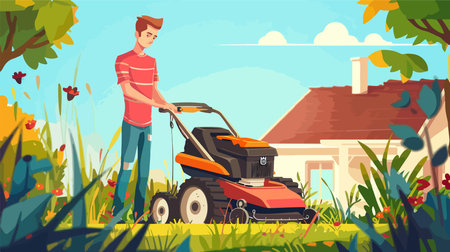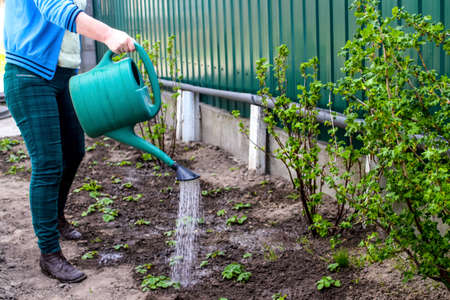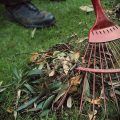1. Water Early or Late in the Day
During the hot summer months, timing is everything when it comes to watering your garden. The best times to water are early in the morning or later in the evening. These cooler parts of the day help reduce water loss due to evaporation and give your plants a better chance to soak up the moisture they need before the heat kicks in.
Watering in the middle of the day, especially during peak sunlight hours, can result in most of the water evaporating before it even reaches the roots. Plus, droplets on leaves under intense sun can act like magnifying glasses and potentially scorch plant foliage.
Why Morning or Evening Watering Works Best
| Time of Day | Benefits |
|---|---|
| Early Morning (before 10 AM) | Minimizes evaporation, gives plants time to absorb water, reduces risk of fungal diseases |
| Late Evening (after 6 PM) | Cools down soil, less evaporation, allows water to reach roots overnight |
Quick Tips for Effective Timing
- If youre an early riser, set up a morning routine to check your gardens moisture needs.
- Use a timer with drip irrigation systems to automate watering schedules at ideal times.
- Avoid late-night watering when possible, as overly damp conditions can invite pests and mildew.
By adjusting your watering schedule to early mornings or late evenings, you’ll help your garden thrive through even the hottest summer days.
2. Adjust Frequency Based on Plant Needs
Not all plants are created equal when it comes to water needs, especially during the summer heat. Some thrive in drier conditions, while others—like many vegetables and flowering annuals—need more consistent moisture. Understanding what your specific plants need can make a big difference in their health and productivity.
Know Your Plants
Start by learning about the types of plants in your garden. Are they native to your region? Are they drought-tolerant? Or do they require frequent watering? This information helps you avoid both underwatering and overwatering.
General Watering Guidelines by Plant Type
| Plant Type | Watering Frequency | Notes |
|---|---|---|
| Vegetables (e.g., tomatoes, cucumbers) | Daily or every other day | Keep soil consistently moist; water early morning or late afternoon |
| Drought-tolerant perennials (e.g., lavender, yarrow) | 1–2 times per week | Allow soil to dry slightly between waterings |
| Flowering annuals (e.g., petunias, impatiens) | Every 1–2 days | Monitor soil moisture closely during hot spells |
| Shrubs and trees (established) | Once per week | Deep soak to encourage strong root systems |
Check Soil Moisture Regularly
The best way to know when to water is to check your soil. Stick your finger about 1–2 inches into the soil near the plant’s base. If it feels dry, its time to water. You can also use a moisture meter for more accurate readings.
Avoid One-Size-Fits-All Schedules
It might be tempting to set a timer and forget it, but automated watering schedules dont always work for every plant. Weather changes, plant growth stages, and soil types all impact how much water your garden actually needs. Adjust your schedule as needed, especially during heatwaves or after heavy rain.

3. Use Mulch to Lock in Moisture
One of the easiest and most effective ways to keep your garden healthy during the summer heat is by applying mulch. A good layer of mulch around your plants helps retain moisture in the soil, regulates soil temperature, and reduces water evaporation — all essential for keeping your garden thriving when temperatures rise.
Mulch acts like a protective blanket for your soil. It shields the ground from the sun’s intense rays and helps prevent water from evaporating too quickly. This means you’ll spend less time watering and more time enjoying your garden.
Benefits of Using Mulch in Summer
| Benefit | Description |
|---|---|
| Moisture Retention | Keeps water in the soil longer, reducing how often you need to water. |
| Temperature Regulation | Helps keep soil cooler during hot days and warmer at night. |
| Weed Control | Blocks sunlight from reaching weed seeds, reducing weed growth. |
| Soil Health | Organic mulches break down over time, adding nutrients to the soil. |
Best Types of Mulch for Hot Weather
- Bark or Wood Chips: Long-lasting and great for flower beds and around trees.
- Straw or Hay: Ideal for vegetable gardens; make sure its seed-free to avoid weeds.
- Compost: Adds nutrients while also helping retain moisture.
How to Apply Mulch
- Clear any weeds or debris from around your plants.
- Add a 2–3 inch thick layer of mulch around the base, making sure not to pile it directly against plant stems or trunks.
- Water the area after applying mulch to help it settle into place.
By using mulch wisely, you can give your garden an edge during those scorching summer days. It’s a simple step that delivers big results when it comes to conserving water and keeping plants happy and hydrated.
4. Choose the Right Watering Tools
When summer temperatures soar, using the right watering tools can make a big difference in keeping your garden healthy while conserving water. Instead of relying on traditional sprinklers or hand-watering with a hose, consider more efficient options that deliver moisture directly to plant roots where its needed most.
Why Soaker Hoses and Drip Irrigation Work Best
Soaker hoses and drip irrigation systems are excellent choices for summer watering. These tools provide slow, steady moisture that penetrates deeply into the soil, helping plants develop strong root systems. They also minimize water loss due to evaporation or runoff, which is especially important during hot and dry conditions.
Comparison of Common Watering Tools
| Watering Tool | Efficiency | Best Use | Water Waste Level |
|---|---|---|---|
| Soaker Hose | High | Garden beds, vegetable patches | Low |
| Drip Irrigation System | Very High | Individual plants, shrubs, container gardens | Very Low |
| Sprinkler | Moderate | Lawn areas | High (due to evaporation and wind) |
| Hand-Held Hose | Low to Moderate | Spot watering or small areas | Moderate to High (depends on technique) |
Tips for Using These Tools Effectively
- Install timers: Automate your watering schedule to avoid over- or under-watering.
- Bury or mulch over hoses: This helps retain moisture and protects the system from sun damage.
- Check for clogs: Regularly inspect drip emitters and hoses for blockages that can restrict water flow.
- Avoid watering at midday: Early morning or late evening is best to reduce evaporation.
Selecting the right tools and using them properly ensures your garden stays lush and healthy even when the heat is on.
5. Watch for Signs of Overwatering or Underwatering
Keeping your garden healthy during the summer heat means more than just sticking to a watering schedule — its also about observing how your plants respond. Pay close attention to how your plants look, because they’ll often show you when something’s off.
Common Signs to Look For
If your plants are struggling, they’ll usually give visual clues. Here’s a simple guide to help you spot issues early:
| Symptom | Possible Cause |
|---|---|
| Wilted leaves (even after watering) | Overwatering or root rot |
| Yellowing leaves | Too much water or poor drainage |
| Crispy, dry leaf edges | Underwatering or hot, dry winds |
| Slow growth or drooping stems | Lack of water or heat stress |
Check the Soil Before You Water
Your soil can tell you a lot about what’s going on underground. Stick your finger an inch or two into the soil near the base of the plant. If it feels dry at that depth, it’s time to water. If it still feels moist, wait another day and check again.
Soil Moisture Test: The Finger Check Method
- Dry: Time to water – soil feels dusty and crumbly.
- Moist: Hold off – soil feels cool and slightly damp.
- Wet: Don’t water – risk of overwatering and root rot.
Adjust Based on What You See
No two gardens are exactly the same. Some areas may dry out faster due to sun exposure or wind. Adjust your watering frequency based on plant appearance and soil condition rather than using a fixed schedule.
The more in tune you are with your garden, the easier it is to keep it happy and hydrated all summer long.


